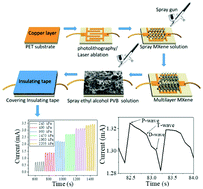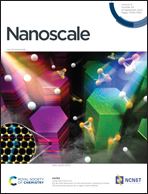A highly sensitive piezoresistive sensor based on MXenes and polyvinyl butyral with a wide detection limit and low power consumption†
Abstract
As a new class of two-dimensional transition-metal carbides and carbonitrides, MXenes have been widely used in energy storage, sensing, catalysis, electromagnetic interference shielding and other fields. It is a challenge to simultaneously realize a sensor with extremely high sensitivity, wide detection limits, low power consumption and good mechanical stability. In this work, taking advantage of the high conductivity of MXenes and the porous structure of polyvinyl butyral, a highly sensitive piezoresistive sensor was fabricated. The fabricated MXene/PVB-based sensor exhibits high sensitivity and reliability with a factor of ∼11.9 kPa−1, ∼1.15 kPa−1 and ∼0.20 kPa−1 in the ranges of 31.2 Pa–312 Pa, 312 Pa–62.4 kPa and 62.4 kPa–1248.4 kPa, respectively. The sensor has a wide detection range (∼31.2 Pa to ∼2.205 MPa), low detection limit (6.8 Pa), low detection voltage (0.1 mV), low power consumption (∼3.6 × 10−10 W), fast response time (∼110 ms) and good mechanical stability (over 10 000 maximum-pressure cycles). Moreover, it is demonstrated that the sensor can detect subtle bending and release activities of humans, including arterial pulses and voice signals, which makes it potentially suitable to be used as a wide detection range, highly sensitive and low power consumption piezoresistive sensor. This work provides a new avenue to expand the application of MXene-based flexible pressure sensors with a wide sensing range and ultra-low power consumption.



 Please wait while we load your content...
Please wait while we load your content...